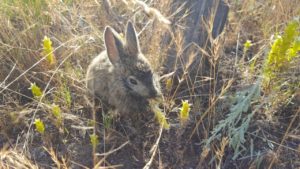All about Pygmy Rabbits
The discussion on the floor of the impromptu meeting of the Reecer Creek Rod, Gun, Working Dog & Outdoor Think Tank Benevolent Association was the recent press coverage of the pygmy rabbits which died in Douglas County’s lightning-sparked Sutherland Canyon fire a week and more ago.
The first question was, “Do we have those pygmy things here in Kittitas County? (“No, and there is no clear evidence that they ever lived west of the Columbia.”) For a moment thereafter, the conversation shifted to our local rabbits, and the fine eating several homeys enjoyed growing up in Paradise. In our region, we have two rabbits – the little (two or so pounds of white meat) Nuttall’s, or mountain, cottontail and its similar-size cousin, the eastern cottontail (both with little bushy white “cotton” tails. Nuttall’s is our only local native rabbit. As it was largely confined to the riparian areas of the Columbia River and its tributaries (such as the Yakima), several high‑minded souls imported eastern cottontails during the 1920s and ’30s, and released them all across Washington. (At the time, demand around the West was such that kids across the country were being paid to raise eastern cottontails for release.)
And. of course, we have hares in Paradise. Snowshoe hares are also called “varying hares,” since they turn white in winter in most of their range, or “Washington hares” in areas where they do not turn. We also have a few black-tailed jackrabbits (hares) on ag ground. (White‑tailed jackrabbits are now found in only a few places like the Okanogan country.) Hares, however, are fodder for another discussion.
At some point, Don’t-Use-My-Name Homey, gave me one of those looks. “Okay, if we don’t have these runt bunnies here in the valley, why do you give a #@!?” “Well,” I allowed, “right after the turn of this Century, several locals went out with biologists Tom McCall and John Musser into the big sage of Douglas County, searching for pygmy rabbits, and it sort of rekindled an ancient relationship in me.”
The way it was, growing up in East Wenatchee in a family of extremely limited means, a lot of my youthful (late ‘40s and early ‘50s) meat gathering had to do with rabbits. I box-trapped and hunted cottontails in the orchards (Nuttall’s and easterns, no doubt) and often wandered at dawn and dusk into the big sage home of the pygmy rabbits. We ate a fair number of both, although my mom preferred the bigger cottontails. When I first learned that they were disappearing, I had to remind myself that loss of habitat was the issue – there were plenty of the mini bunnies in abundant habitat at the time I was after them. “Besides,” I said to Homey, “these are very cool and unique little mammals. Think about it…”
The pygmy rabbit is the smallest rabbit in the world. An adult weighs from 12 ounces to slightly over a pound, and is from nine inches to less than a foot long – one would fit on your hand. Its distinguishing characteristics include its small size, short ears, a white spot by its nostril, gray color, small hind legs, and lack of white fur on its one-inch tail. When it spooks, it is running – scampering – rather than leaping. On top of all that, it is one of only two rabbits in North America which digs its own burrows (although it will occupy others, as needed).
 Pygmy rabbit’s scientific name is Brachylagus idahoensis. It is most active at dawn and dusk. Litters average six babies, and a pair may produce three litters annually by the end of June. (Photo of the pygmy eating owl clover by Washington Department of Fish and Wildlife’s Kourtney Stonehouse.)
Pygmy rabbit’s scientific name is Brachylagus idahoensis. It is most active at dawn and dusk. Litters average six babies, and a pair may produce three litters annually by the end of June. (Photo of the pygmy eating owl clover by Washington Department of Fish and Wildlife’s Kourtney Stonehouse.)
Pygmy rabbits occupy a very unique habitat, and therein lies the problem with their future. They are found primarily in habitats dominated by big sagebrush and rabbitbrush, and, to a lesser extent, in areas with abundant greasewood. Year around, nearly 90% of their diet is sagebrush leaves. Much of this native habitat has gone to agriculture and urban development. Burrows are generally into slopes at the base of big sage plants, facing north to east, and may have several three-inch entrances, with trails leading about. In poor burrowing areas, the rabbits may occupy holes in stone walls, around volcanic rocks or burrows made by other animals.
Pygmy rabbits have apparently lived in the shrub-steppe of central Washington for at least 100,000 years. By 2001, only 16 individuals were known statewide; by 2003, pygmy rabbits were listed as endangered at both state and federal levels. There are other, less isolated, populations in the Great Basin states, as well as Montana, Idaho, Oregon, and Wyoming.
Learn more about these interesting bunnies and their future, and find photos, on line.
While 70 rabbits died as the fire swept through the Beezley Hills breeding compound in Douglas County, a number survived, and were moved to one of the other breeding facilities. There is still a fair number of the rabbits making more. Just during this decade, DFW has release hundreds of pygmy rabbits into the wild – all part of a determined restoration effort involving USFWS, universities, zoos and outfits like the Nature Conservancy. The goal of all players is to return populations to sustainable levels.
Here’s to their successful efforts.







